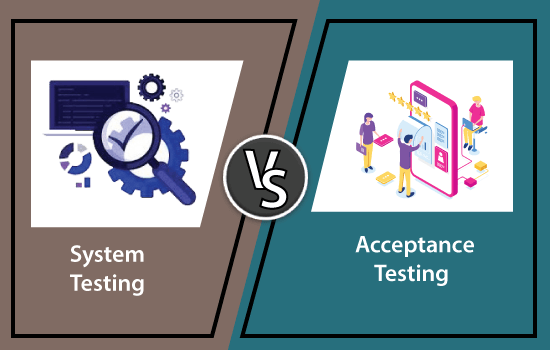In this section, we are going to discuss what is system testing and acceptance testing in Software Testing; and see the significant differences between them.
The system and acceptance testing both are methods of dynamic testing used to verify all the built-in requirements in the software or the application.
Based on testing performance, we can categorize the testing into two subcategories: System Testing and Acceptance Testing.
As we already knew, the SDLC (Software Testing Life Cycle) includes multiple stages, where the application testing phase involves the process of System testing and Acceptance testing.
Firstly, we will execute the system testing and then the acceptance testing on the application before the software product's beta and alpha releases.
Now, let's see a brief introduction of System Testing and Acceptance Testing approaches.
What is System testing?
In functional testing, system testing is used to analyze the end-to-end flow of an application.
We navigate all the required modules of an application, analysis if the end features work fine, and test the product as an entire system.
In system testing, the test environment is parallel to the production environment; that's why it is also known as end-to-end testing. And it contains the SIT (System Integration Testing) and the ST (System Testing).
For more details about system testing, refers to the following link: https://www.javatpoint.com/system-testing.
What is Acceptance Testing?
Acceptance testing or User acceptance testing (UAT) is another classification of software testing performed by the customer before accepting the final product.
Generally, acceptance testing is used to evaluate whether the application works as per the specified business requirements or real-time scenarios.
UAT testing is executed on the customer's unique environment, which is acknowledged as the UAT environment.
For more details about acceptance testing, refers to the following link: https://www.javatpoint.com/acceptance-testing.
System Testing VS. Acceptance Testing
Let's see the key difference between system testing and acceptance testing:

|
S.no. |
Comparison basis |
System Testing |
Acceptance Testing |
|
1 |
Definition |
System testing is
performed to test end to end functionality of the software. |
Acceptance testing
is performed to test whether the software is conforming specified
requirements and user requirements or not. |
|
2 |
Executed by |
Only developers and
testers can perform System testing. |
It can be performed
by testers, stakeholders and costumers. |
|
3 |
Part of |
It can be both
non-functional and functional testing. |
It can be only
functional testing. |
|
4 |
Analysis |
In System testing,
we test the performance of the whole system. |
In Acceptance
testing, we test whether the system is conforming requirements or not. |
|
5 |
Inputs |
System testing uses
demo input values that are selected by the testing team. |
Acceptance testing
uses the actual real-time input values provided by the user. |
|
6 |
Test coverage |
In this testing, we
include the testing of complete specification including software and
hardware, memory and number of users. |
Here we test whether
the software is fulfilling all the needs of the user or not. |
|
7 |
Combination of |
System Testing is a
combination of System Testing and Integration testing. |
Acceptance Testing
is a combination of alpha testing and beta testing. |
|
8 |
Order of execution |
It is performed
before the Acceptance testing. |
It is performed
after the System testing. |
|
9 |
Included another type of testing |
System testing
involves load and stress testing under non-functional testing. |
Acceptance testing
involves boundary value analysis, equivalence portioning and decision table
under functional testing. |
|
10 |
Bug fixes |
The defects found in
system testing are considered to be fixed. |
The defects found in
acceptance testing are considered as product failure. |
Conclusion
Here, we can conclude that both system and acceptance testing play a significant role while testing any software or application.
In other words, we can say that System testing is primarily performed to test the needs of a system. On the other hand, acceptance testing is implemented to validate the system performance through an end-user, and UAT is executed by the domain expert(customer) for their satisfaction.
System testing is a type of black-box testing that is being performed to validate the integrated software or application in contradiction to the detailed requirements.
User acceptance or acceptance testing includes testing the software, compared to the user requirement, to meet the acceptance measures and get software products readily known.
In acceptance testing, the business representatives' must be satisfied that the developed product sees their needs in the business environment. And System testing should meet the productivity requirements of the system.



0 Comments